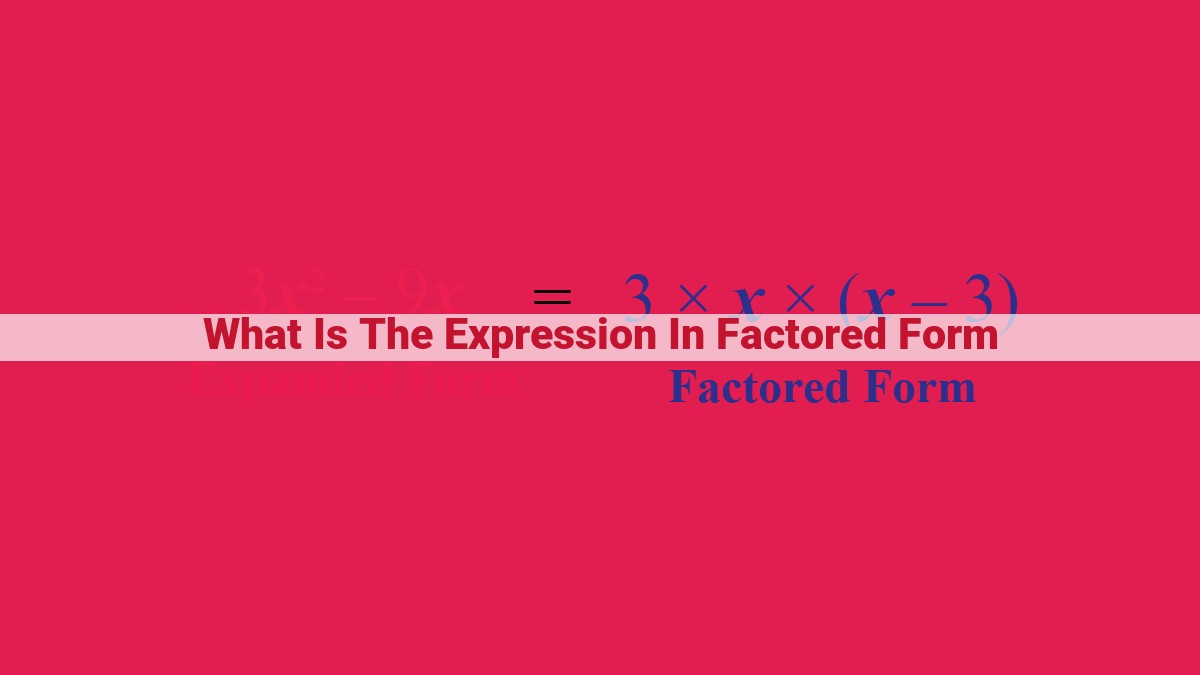Master Expression Factoring: A Guide To Simplifying Mathematicalexpressions

An expression in factored form represents a mathematical expression as a product of its irreducible factors. Factoring an expression involves breaking it down into smaller components that can be multiplied together to obtain the original expression. By understanding the concept of linear and quadratic factors and utilizing techniques such as finding the greatest common factor (GCF) and grouping, expressions can be effectively factored into their simplest form.
Understanding Expressions in Factored Form: A Comprehensive Guide
Factorization is a fundamental concept in algebra that involves breaking down complex algebraic expressions into simpler factors. It plays a pivotal role in simplifying expressions, solving equations, and understanding the underlying structure of polynomials.
Factoring is the process of expressing a given polynomial as a product of its factors. By breaking down an expression into its constituent parts, we can simplify it, identify its zeros, and gain insights into its behavior.
Types of Expressions That Can Be Factored
Not all expressions can be factored. However, most polynomials can be factored into linear factors or quadratic factors.
- Linear factors are expressions of the form (ax + b) and are the simplest type of factors.
- Quadratic factors are expressions of the form (ax² + bx + c), where a is not equal to 0. These factors can be further classified into prime polynomials, difference of squares, perfect square trinomials, and sum and difference of cubes.
Concept: Linear Factors
- Definition of linear factors
- Examples of linear factors
Concept: Linear Factors
In the realm of mathematics, factoring expressions involves breaking them down into simpler components called factors. Like a puzzle, each expression can be dissected into a set of building blocks that, when multiplied together, recreate the original expression. Linear factors, the simplest building blocks of this mathematical puzzle, play an essential role in the process of factorization.
Definition of Linear Factors
A linear factor is a polynomial expression of the first degree, meaning it contains only one variable raised to the power of one. This variable can be represented by any letter, but typically uses “x”. A constant term may also accompany the variable, adding a fixed value to the expression.
Examples of Linear Factors
Linear factors manifest in various forms. Some common examples include:
- (2x + 3): This expression consists of the variable “x” multiplied by the coefficient “2” and a constant “3”.
- (x – 5): Here, the variable “x” is subtracted by the constant “5”.
- (3x): A linear factor can also be a simple multiple of the variable, such as “3x”.
Significance of Linear Factors
Linear factors serve as the foundation for more complex factorization methods. By understanding and manipulating linear factors, we can begin to unlock the doors to higher-order factorization techniques. They are the building blocks of quadratic and polynomial expressions, enabling us to solve equations, simplify expressions, and gain a deeper understanding of algebraic principles.
Concept: Quadratic Factors
When it comes to factoring, quadratic factors are a fundamental concept that plays a crucial role in simplifying expressions and solving equations. They are characterized by their quadratic form, which is ax^2 + bx + c.
Different Forms of Quadratic Factors
Quadratic factors can take on various forms, each with its own unique characteristics:
-
Prime Polynomials: These are quadratic factors that cannot be further factored into smaller polynomials. Examples include x^2 + 1 and x^2 – 4.
-
Difference of Squares: This form is derived from the difference of two perfect squares and takes the form a^2 – b^2. It can be factored as (a + b)(a – b).
-
Perfect Square Trinomials: These factors are the squares of binomials and appear as (ax + b)^2. They can be factored as (ax + b)(ax + b).
-
Sum and Difference of Cubes: These factors involve the sum or difference of two cubes and have the form a^3 ± b^3. They can be factored as (a ± b)(a^2 ∓ ab + b^2).
Factoring Techniques: Unveiling the Secrets of Expressions
Factoring, a technique in algebra, unravels the complexities of expressions, transforming them into simpler and more manageable forms. Two powerful techniques emerge as the keys to this transformation: the Greatest Common Factor (GCF) and grouping.
The Greatest Common Factor (GCF): Unifying the Multiple
The GCF, the greatest common multiple of two or more terms, represents the greatest factor shared by all. Multiplying all terms by the reciprocal of the GCF eliminates common factors, leaving only their unique components.
Grouping: Breaking Down the Complex
Grouping involves partitioning an expression into smaller, manageable groups. By strategically identifying common factors within each group, factoring becomes possible. This technique allows us to factor out shared terms, revealing hidden structure within complex expressions.
Harnessing the Power of Factoring
Factoring is not merely an academic exercise; it empowers us to simplify, solve, and understand expressions with remarkable efficiency. From reducing fractions to solving equations, factoring unlocks a world of mathematical possibilities.
Simplifying Expressions:
Factoring transforms complex expressions into more manageable forms, making them easier to work with. By eliminating common factors, we can simplify calculations and streamline our mathematical computations.
Solving Equations:
Factoring is an indispensable tool for solving equations. By expressing an equation as a product of factors, we can identify the solutions that satisfy both factors simultaneously. This method provides an elegant and efficient approach to problem-solving.
Understanding Expressions:
Factoring unveils the underlying structure of expressions, revealing patterns and relationships that may not be apparent at first glance. It grants us a deeper understanding of mathematical constructs and empowers us to manipulate expressions with confidence.